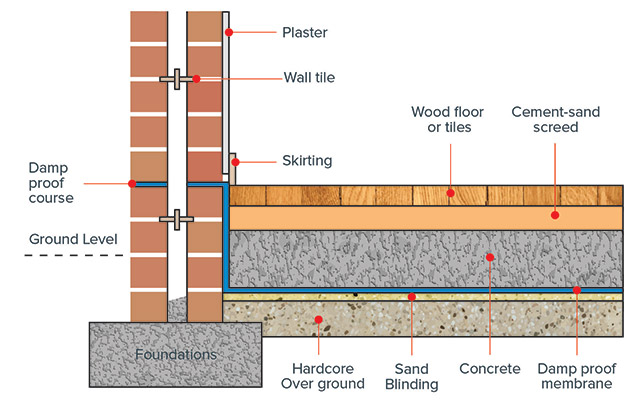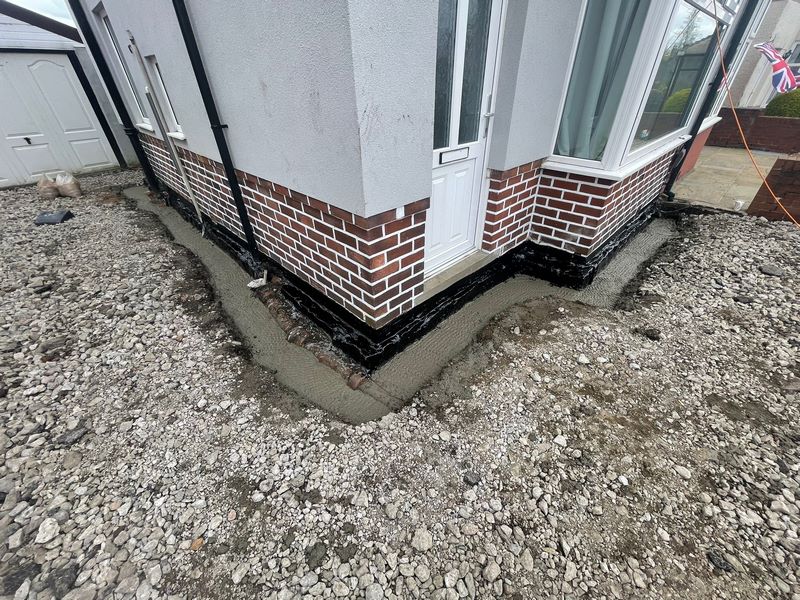Step-by-step guide for damp specialist newcastle to identify moisture issues early
Checking Out the Various Methods and Solutions for Effective Damp Proofing
Moisture in buildings postures significant challenges to both structural integrity and interior air top quality. Different techniques and solutions have actually emerged to combat this prevalent problem. From standard damp-proof membrane layers to innovative chemical treatments, each method supplies special benefits. Recognizing these alternatives is necessary for reliable wetness control. Picking the right service depends on details structure problems and demands, triggering further exploration into the most reliable damp proofing techniques readily available.
Comprehending the Reasons of Moisture
Moisture can occur from various resources, understanding these reasons is important for effective remediation. Commonly, wetness originates from 3 primary sources: climbing wet, passing through damp, and condensation. Rising moist takes place when groundwater travels up through porous materials, such as block or rock, usually due to an absence of an effective obstacle (damp proofing newcastle). Permeating damp is typically triggered by outside factors, consisting of roofing leakages, faulty rain gutters, or harmed wall surfaces, allowing water to infiltrate a home. Condensation, on the other hand, arises from excess moisture in the air, commonly aggravated by inadequate air flow and temperature distinctions, causing water beads creating on surfaces. Identifying these underlying concerns is vital, as each type of wetness requires a customized technique for removal. Appropriate evaluation assists in determining the most reliable options, ultimately safeguarding the architectural honesty of a structure and boosting indoor air quality
Typical Damp-Proof Membrane Layers

Chemical Damp-Proofing Solutions
Chemical damp-proofing services supply an ingenious method to avoid wetness breach in structures. These techniques normally include the application of fluid chemicals that penetrate stonework and develop an obstacle against climbing damp. Typically used chemicals consist of silanes, siloxanes, and other water-repellent representatives that react with surface area materials to develop a hydrophobic layer.The application procedure typically calls for drilling openings right into the walls, injecting the chemical remedy, and allowing it to heal. This method is specifically useful for older structures where conventional damp-proof membrane layers may be impractical. Chemical damp-proofing can be much less disruptive and a lot more economical than substantial renovation projects.While reliable, these remedies depend on correct application and ecological problems for peak performance. mould removal newcastle. Regular upkeep and surveillance are essential to guarantee the longevity of the damp-proofing therapy. Generally, chemical damp-proofing stands for a flexible choice for guarding structures against moisture-related damage
Cavity Wall Surface Building And Construction Techniques
Tooth cavity wall surface building methods supply various benefits, particularly in wetness control and power performance. By including an air void in between two layers of masonry, these walls effectively minimize water ingress while enhancing insulation. This combination not only safeguards structures from moisture however also contributes to lowered power usage.
Benefits of Tooth Cavity Wall Surfaces
When thinking about effective wet proofing approaches, the benefits of dental caries wall surfaces attract attention prominently. Dental caries walls are composed of two different layers, producing an air gap that properly minimizes dampness penetration. This design lessens the risk of dampness, as the outer wall serves as a barrier against rainfall and water access. Additionally, cavity wall surfaces boost thermal insulation, which adds to power performance by reducing warmth loss. They likewise supply sound insulation, assisting to create a quieter interior setting. The air space allows for ventilation, which assists in moisture control and lowers the possibility of mold growth. These advantages not just boost the overall comfort of a structure yet also contribute to its durability and architectural stability.
Wetness Control Techniques
Efficient dampness control techniques are critical in cavity wall surface construction to guarantee long-lasting protection versus dampness. One key technique entails the incorporation of weep holes, which assist in water drainage from the tooth cavity, protecting against buildup. In addition, using breathable membranes can help take care of moisture levels while enabling trapped vapor to run away. Proper placement of insulation is additionally critical, as it needs to not block drainage courses. Guaranteeing that the outer leaves of the dental caries wall surface are constructed with waterproof materials enhances general sturdiness. Routine maintenance checks are necessary to identify any type of obstructions or damage early, safeguarding the framework's honesty. Eventually, a combination of these strategies creates a robust protection against dampness invasion in tooth cavity walls.
Insulation and Power Performance
Insulation plays a vital function in enhancing energy efficiency within dental caries wall surface building. By incorporating insulating materials, these walls develop a thermal obstacle that minimizes heat loss and reduces power usage. Effective insulation not just aids maintain a secure indoor temperature level however additionally mitigates the risk of moisture, as it avoids condensation within the wall cavity. Various strategies, such as using rigid foam boards or mineral wool, can be employed to accomplish optimal insulation performance. Additionally, correct installation is important to ensure that gaps and voids are decreased, which can or else endanger energy performance. Ultimately, a well-insulated tooth cavity wall contributes substantially to overall sustainability and reduces cooling and heating prices for homeowners.
External Damp Proofing Approaches
External damp proofing methods are vital for protecting frameworks from dampness seepage. 2 effective strategies consist of the application of water-proof membranes and the setup of French drains pipes. These options help reduce water buildup and maintain the integrity of buildings.
Waterproof Membrane Application
While numerous methods exist for avoiding dampness ingress, the application of water-proof membranes remains an extremely efficient external wet proofing method. These membranes are typically made from products such as polyethylene, rubber, or changed bitumen, providing a durable barrier against water penetration. The installation procedure involves applying the membrane layer to the external surfaces of foundations or wall surfaces, ensuring complete protection to stop leakages. Proper bond and securing at joints are critical to making the most of efficiency. Waterproof membranes can be applied in various kinds, consisting of liquid coatings and sheet membranes, permitting flexibility based upon the certain demands of the structure. This approach not just protects structures from moisture yet additionally enhances their long life and structural honesty.
French Drain Installation
One reliable method for handling groundwater and stopping moisture accumulation around a building's foundation is the installation of a French drain. This water drainage system is composed of a trench loaded with crushed rock and a perforated pipeline that reroutes surface water far from the structure. Correct setup requires mindful planning, making sure that the drainpipe slopes far from the structure to facilitate perfect water flow. In addition, the place of the drain is vital; it must be positioned in locations prone to merging or excess wetness. Regular upkeep, consisting of cleaning particles from the gravel and ensuring the pipe stays unhampered, is necessary for long-lasting effectiveness. Ultimately, a well-installed French drain can substantially lower the risk of water-related issues in cellars and foundations.
Inside Waterproofing Methods
Interior waterproofing techniques are essential for securing a building's interior from moisture infiltration and prospective water damage. These methods generally entail the application of specialized materials and methods created to develop a dampness barrier within the structure. One usual approach is the usage of water-proof coverings or sealants on wall surfaces and floorings, which protect against moisture from passing through surfaces.Additionally, mounting interior water drainage systems, such as sump pumps, can properly manage water buildup in cellars and creep spaces. Another approach includes using vapor barriers, which are mounted to hinder dampness movement from the ground right into living spaces.Moreover, addressing any kind of cracks or voids in walls or structures with ideal sealants assures a complete defense against water intrusion. By carrying out these interior waterproofing techniques, residential property owners can significantly minimize the risk of mold development, structural damage, and various other moisture-related problems. Appropriate implementation of these techniques is crucial for lasting protection and building integrity.
Routine Upkeep and Inspection Practices
Normal upkeep and inspection methods are essential for ensuring the long-lasting effectiveness of moist proofing services in any kind of structure. Routine checks enable homeowner to determine early indications of wetness breach, such as peeling off paint, mold development, and mildewy smells. These indicators can signal underlying problems that require instant attention.Inspections need to be conducted a minimum of every year, concentrating on prone locations like basements, creep spaces, and outside walls. During these evaluations, homeowner need to take a look at sealants, drain systems, and air flow to validate they work correctly.Additionally, maintaining gutters and downspouts is crucial, as clogged up systems can bring about water build-up near the structure. Applying a normal maintenance routine, together with timely repair services, can considerably prolong the lifespan more info of moist proofing measures and safeguard the architectural stability of the structure. Aggressive actions inevitably add to the overall health and wellness and safety of the living setting.
Regularly Asked Inquiries
How Much Time Does Damp Proofing Normally Last?
The duration of wet proofing performance varies, generally lasting in between 20 to half a century. Factors such as application top quality, environmental conditions, and maintenance techniques considerably affect the durability of the damp proofing treatment.

Can I Damp Evidence My Home Myself?
The private contemplated the usefulness of DIY damp proofing. With proper research and the appropriate materials, it is possible. Nonetheless, they additionally identified the value of specialist assistance to guarantee resilient effectiveness and prevent future issues.
What Are the Indications of Ineffective Damp Proofing?
Signs of inadequate wet proofing consist of persistent musty odors, visible mold and mildew growth, peeling off paint, moist patches on wall surfaces, and timber degeneration - damp specialist newcastle. Homeowners should attend to these concerns immediately to avoid further damages and health concerns
Does Damp Proofing Affect Indoor Air Top Quality?

Exactly How Much Does Expert Damp Proofing Cost?
Specialist wet proofing prices vary considerably, normally varying from $1,000 to $5,000 relying on the building's size, the level of the wet problem, and picked approaches. Each scenario requires a customized analysis for accurate pricing. Commonly, moisture originates from 3 primary resources: increasing damp, passing through moist, and condensation. When thinking about efficient damp proofing approaches, the advantages of tooth cavity wall surfaces stand out plainly. Exterior wet proofing methods are vital for securing frameworks from moisture seepage. While numerous methods exist for stopping moisture access, the application of water resistant membranes continues to be a very effective outside moist proofing technique. Indicators of inadequate wet proofing consist of relentless stuffy smells, noticeable mold and mildew growth, peeling off paint, moist patches on wall surfaces, and timber degeneration.